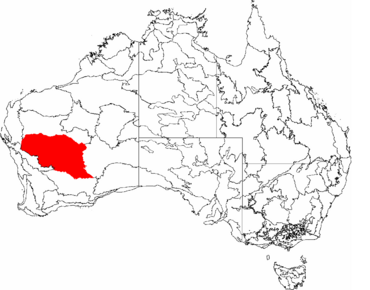Murchison (Western Australia) facts for kids
Quick facts for kids MurchisonWestern Australia |
|||||||||||||||
|---|---|---|---|---|---|---|---|---|---|---|---|---|---|---|---|

The interim Australian bioregions,
with Murchison in red |
|||||||||||||||
| Area | 281,205.54 km2 (108,574.1 sq mi) | ||||||||||||||
|
|||||||||||||||
The Murchison is a large area in the middle of Western Australia. It's part of the Mid West region. This area became famous in the 1890s because of a big gold rush. Today, it's still an important place for mining.
The Murchison is also known as an Australian bioregion. A bioregion is a large natural area with similar plants, animals, and climate. The Murchison bioregion is roughly connected to the area where the Murchison River collects its water. It covers a huge area of about 281,205 square kilometres.
Contents
Exploring the Murchison's Landscape
The Murchison region has a unique look. You'll see low hills and flat-topped mountains called mesas. These are separated by flat areas made of loose soil and rocks, as well as wide plains formed by rivers.
Rivers and Waterways
The western part of the Murchison bioregion has two main rivers. These are the upper parts of the Murchison River and the Wooramel River. Both of these rivers flow west towards the coast.
Connected Natural Areas
The Murchison bioregion is linked to the Gascoyne bioregion. Together, they form a bigger natural area called the Western Australian mulga shrublands. This means they share similar types of plants and landscapes.
Towns and Communities
Not many people live in the Murchison, and the towns are far apart. The biggest towns are Meekatharra, Mount Magnet, and Leonora. There are also smaller towns that grew because of mining or farming. These include Yalgoo, Sandstone, Cue, Wiluna, and Leinster.
Murchison's Two Main Parts
The Murchison bioregion is divided into two smaller sections:
- Eastern Murchison (MUR01) – This part is very large, covering about 21,135,040 hectares.
- Western Murchison (MUR02) – This part is smaller, covering about 6,985,514 hectares.
Murchison's Climate
The Murchison has a very dry climate. Most of its rain falls during the winter months. This dry weather shapes the types of plants and animals that can live here.
Plants and Animals of the Murchison
The most common plants in the Murchison are low woodlands and shrublands. These areas are mostly covered by a tree called mulga (Acacia aneura). Underneath the mulga trees, you'll find small, short-lived plants and grasses that grow after it rains.
Other Plant Communities
Other types of plants grow in different parts of the Murchison:
- Saltbush shrubland: These plants, like Atriplex species, grow in salty soils.
- Samphire shrubland: These small, salty plants, like Tecticornia species, grow in wet, salty river plains.
- Hummock grassland: You'll find these grassy areas on red sand plains.
How Land is Used in the Murchison
The Murchison is one of the main areas in Western Australia for farming animals. It has many large pastoral leases. These are huge areas of Crown land where farmers raise sheep and cattle stations.
Mining in the Region
Mining is the biggest part of the Murchison's economy. People dig for valuable minerals like gold, iron, and nickel. Because of all the mining over the years, there are many old mining towns that are now empty.
Australian Square Kilometre Array Pathfinder
A special radio telescope called the Australian Square Kilometre Array Pathfinder is located near the Murchison. It was officially opened in October 2012. This telescope helps scientists study space.
Protected Natural Areas
Over the years, the Western Australian Government has bought some of the large farming areas. This has helped to create more protected land for nature. In 1998, only about 0.5% of the bioregion was protected. By 2004, this had grown to 6.7%.
Important Protected Places
Some of the protected areas in the Murchison include:
- Bullock Holes Timber Reserve
- De La Poer Range Nature Reserve
- Goongarrie National Park
- Matuwa and Kurrara-Kurrara Indigenous Protected Area
- Queen Victoria Spring Nature Reserve
- Toolonga Nature Reserve
- Wanjarri Nature Reserve

